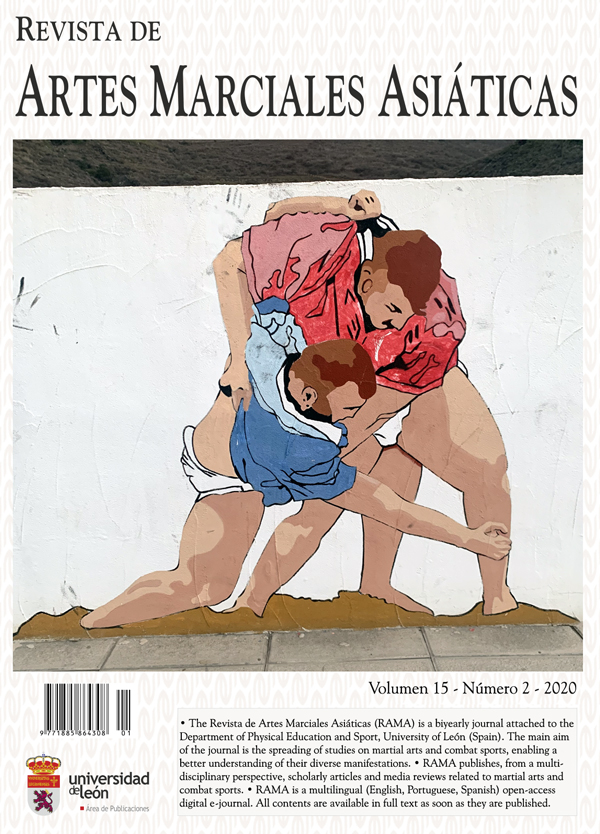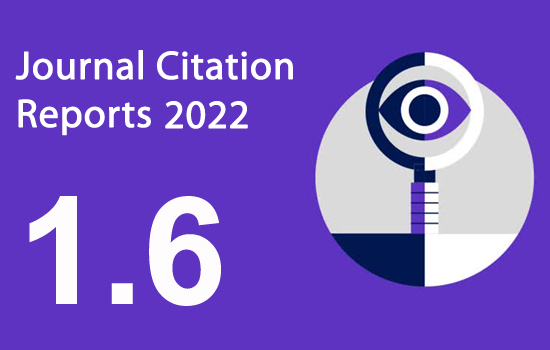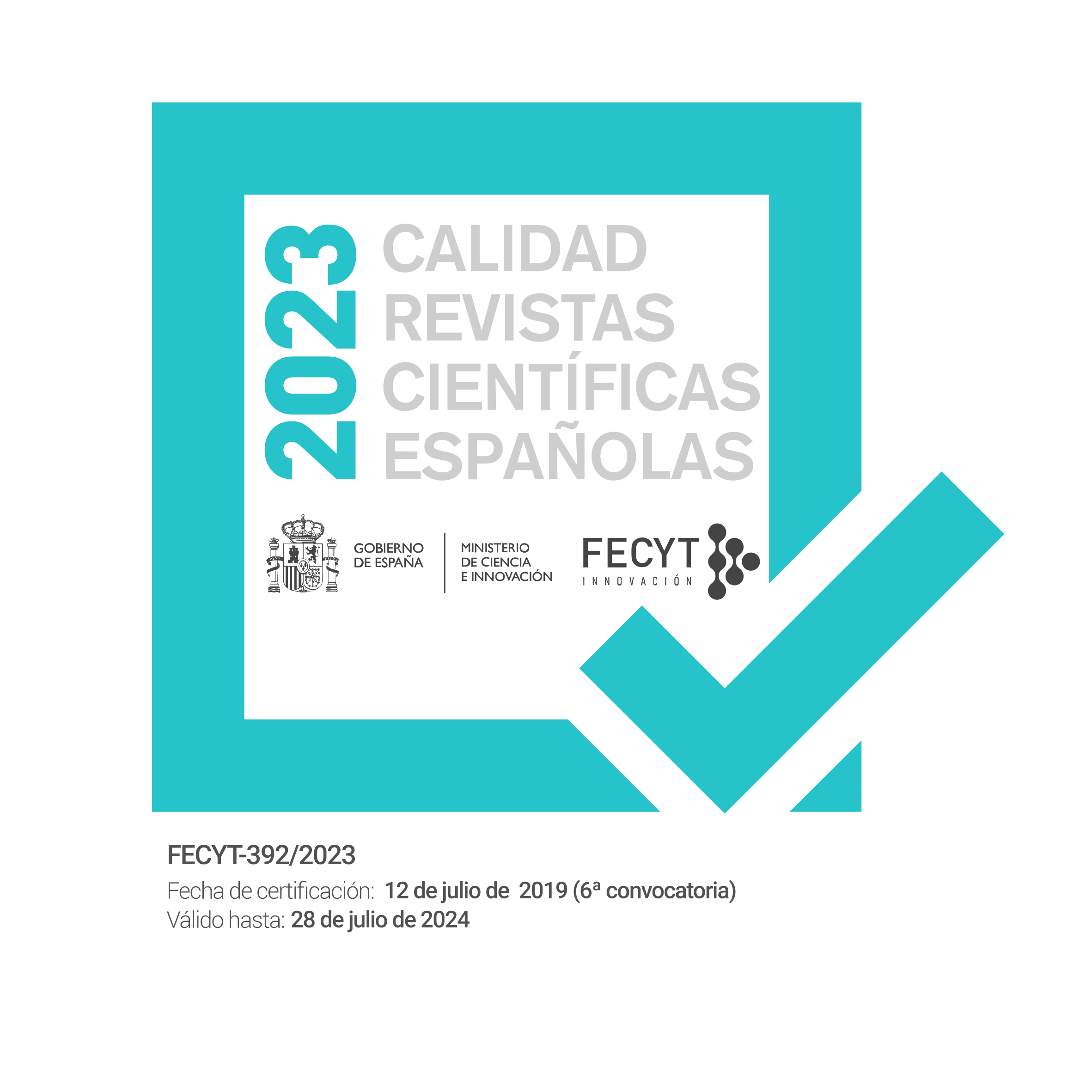El rendimiento mejora en ausencia de espectadores: datos pareados de luchadores de artes marciales mixtas durante la COVID-19
DOI:
https://doi.org/10.18002/rama.v15i2.6294Palabras clave:
Deportes de combate, artes marciales, artes marciales mixtas, COVID-19, análisis de rendimiento, facilitación socialResumen
Durante la COVID-19, los deportistas han tenido que competir sin público. Se ha demostrado que el rendimiento deportivo y cognitivo puede aumentar o disminuir al competir con o sin espectadores, lo se ha denominado "facilitación social". Este estudio investigó este efecto mediante un experimento naturalista debido a la pandemia actual, en un deporte, las artes marciales mixtas (MMA), en el que nunca había sido analizado. Se construyó una variable de rendimiento y se recopilaron datos de 86 luchadores que compitieron durante la COVID-19, comparándolos con sus historiales de competiciones anteriores. En total, se analizaron 586 combates. Se exploró la distribución de datos y los supuestos estadísticos, encontrando una distribución no normal. Seguidamente, se realizó un test de homogeneidad marginal y un test de Rangos con Signo de Wilcoxon. Los resultados mostraron que los luchadores de MMA que ganaron su combate sin audiencia mostraron un peor rendimiento en combates anteriores, con espectadores. Este estudio profundiza en la noción de efectos de facilitación social y sugiere que puede existir la necesidad de incorporar de forma proactiva alternativas de entrenamiento, que podrían mitigar la disminución de rendimiento en luchadores propensos a sufrir este efecto negativo debido a estímulos externos, como son los espectadores. Sin embargo, debido a las observaciones limitadas en la condición de sin espectadores, los resultados de este estudio deben interpretarse con cautela y considerarse muy preliminares.
Descargas
Métricas alternativas
Citas
Amtmann, J. A. (2004). Self-reported training methods of mixed martial artists at a regional reality fighting event. Journal of Strength and Conditioning Research, 18(1), 194–196. doi: https://doi.org/10.1519/00124278-200402000-00029
Andrade, A., Batalha Silva, R., & Dominski, F. H. (2020). Application of sport psychology to mixed martial arts. Kinesiology, 52(1), 94–102. doi: https://doi.org/10.26582/k.52.1.12
Balmer, N. J., Nevill, A. M., & Lane, A. M. (2005). Do judges enhance home advantage in European championship boxing? Journal of Sports Sciences, 23(4), 409–416. doi: https://doi.org/10.1080/02640410400021583
Blomqvist Mickelsson, T. (2020). Modern unexplored martial arts–what can mixed martial arts and Brazilian Jiu-Jitsu do for youth development? European Journal of Sport Science, 20(3), 386–393. doi: https://doi.org/10.1080/17461391.2019.1629180
Blue, S. (2013). Ongoing Change in the Rhythms of Mixed Martial Arts Practice. The International Journal of Sport and Society: Annual Review, 3(3), 161–170. doi: https://doi.org/10.18848/2152-7857/cgp/v03i03/53911
Böheim, R., Grübl, D., & Lackner, M. (2019). Choking under pressure – Evidence of the causal effect of audience size on performance. Journal of Economic Behavior and Organization, 168, 76–93. doi: https://doi.org/10.1016/j.jebo.2019.10.001
Bond, C. F., & Titus, L. J. (1983). Social facilitation: A meta-analysis of 241 studies. Psychological Bulletin, 94(2), 265–292. doi: https://doi.org/10.1037/0033-2909.94.2.265
Carnes, A. J., Petersen, J. L., & Barkley, J. E. (2016). Effect of Peer Influence on Exercise Behavior and Enjoyment in Recreational Runners. Journal of Strength and Conditioning Research, 30(2), 497–503. doi: https://doi.org/10.1519/JSC.0000000000001064
Claypoole, V. L., & Szalma, J. L. (2018). Facilitating sustained attention: Is mere presence sufficient? American Journal of Psychology, 131(4), 417–428. doi: https://doi.org/10.5406/amerjpsyc.131.4.0417
Craske, M. G., Kircanski, K., Zelikowsky, M., Mystkowski, J., Chowdhury, N., & Baker, A. (2008). Optimizing inhibitory learning during exposure therapy. Behaviour Research and Therapy, 46(1), 5–27. doi: https://doi.org/10.1016/j.brat.2007.10.003
Dunnigan, K. (2013). Tests of marginal homogeneity and special cases. Pharmaceutical Statistics, 12(4), 213–216. doi: https://doi.org/10.1002/pst.1573
Edwards, A. M., Dutton-Challis, L., Cottrell, D., Guy, J. H., & Hettinga, F. J. (2018). Impact of active and passive social facilitation on self-paced endurance and sprint exercise: Encouragement augments performance and motivation to exercise. BMJ Open Sport and Exercise Medicine. doi: https://doi.org/10.1136/bmjsem-2018-000368
Ferreira Julio, U., Panissa, V. L. G., Miarka, B., Takito, M. Y., & Franchini, E. (2013). Home advantage in judo: A study of the world ranking list. Journal of Sports Sciences. doi: https://doi.org/10.1080/02640414.2012.725855
Franchini, E., & Takito, M. Y. (2016). Home advantage in combat sports during the Olympic Games. Sport Sciences for Health, 12(3), 287–290. doi: https://doi.org/10.1007/s11332-016-0286-9
García, R. S., & Malcolm, D. (2010). Decivilizing, civilizing or informalizing? the international development of mixed martial arts. International Review for the Sociology of Sport, 45(1), 39–58. doi: https://doi.org/10.1177/1012690209352392
Gayton, W. F. (1992). Home Advantage: Does It Exist in Individual Sports. Perceptual and Motor Skills, 74(3), 706. doi: https://doi.org/10.2466/pms.74.3.706-706
Greer, D. L. (1983). Spectator Booing and the Home Advantage: A Study of Social Influence in the Basketball Arena. Social Psychology Quarterly, 46(3), 252. doi: https://doi.org/10.2307/3033796
Hibbert, A. W., Billaut, F., Varley, M. C., & Polman, R. C. J. (2018). Goal orientation and the presence of competitors influence cycling performance. Frontiers in Psychology. doi: URhttps://doi.org/10.3389/fpsyg.2018.01212L
James, L. P., Haff, G. G., Kelly, V. G., & Beckman, E. M. (2016). Towards a Determination of the Physiological Characteristics Distinguishing Successful Mixed Martial Arts Athletes: A Systematic Review of Combat Sport Literature. Sports Medicine, 46(10), 1525–1551. doi: https://doi.org/10.1007/s40279-016-0493-1
James, L. P., Sweeting, A. J., Kelly, V. G., & Robertson, S. (2019). Longitudinal Analysis of Tactical Strategy in the Men’s Division of the Ultimate Fighting Championship. Frontiers in Artificial Intelligence, 2. doi: https://doi.org/10.3389/frai.2019.00029
Jensen, P., Roman, J., Shaft, B., & Wrisberg, C. (2013). In the cage: MMA fighters’ experience of competition. Sport Psychologist, 27(1), 1–12. doi: https://doi.org/10.1123/tsp.27.1.1
Kirk, C., Clark, D. R., Langan-Evans, C., & Morton, J. P. (2020). The physical demands of mixed martial arts: A narrative review using the ARMSS model to provide a hierarchy of evidence. Journal of Sports Sciences, 1–23. doi: https://doi.org/10.1080/02640414.2020.1802093
La Bounty, P., Campbell, B. I., Galvan, E., Cooke, M., & Antonio, J. (2011). Strength and conditioning considerations for mixed martial arts. Strength and Conditioning Journal, 33(1), 56–67. doi: https://doi.org/10.1519/SSC.0b013e3182044304
Manstead, A. S. R., & Semin, G. R. (1980). Social facilitation effects: Mere enhancement of dominant responses? British Journal of Social and Clinical Psychology, 19(2), 119–135. doi: https://doi.org/10.1111/j.2044-8260.1980.tb00937.x
Miarka, B., Coswig, V. S., & Amtmann, J. (2019). Long MMA fights technical-tactical analysis of mixed martial arts: implications for assessment and training. International Journal of Performance Analysis in Sport, 19(2), 153–166. doi: https://doi.org/10.1080/24748668.2019.1579030
Paulus, P. B., & Cornelius, W. L. (1974). An analysis of gymnastic performance under conditions of practice and spectator observation. Research Quarterly of the American Alliance for Health, Physical Education and Recreation, 45(1), 56–63. doi: https://doi.org/10.1080/10671188.1974.10615240
Paulus, P. B., Shannon, J. C., Wilson, D. L., & Boone, T. D. (1972). The effect of spectator presence on gymnastic performance in a field situation. Psychonomic Science, 29(2), 88–90. doi: https://doi.org/10.3758/BF03336578
Reade, J. J., Schreyer, D., & Singleton, C. (2020). Echoes: What Happens when Football Is Played behind Closed Doors? SSRN Electronic Journal, March. doi: https://doi.org/10.2139/ssrn.3630130
Ribeiro, V. B., Oliveira, S. R. G. de, & Silva, F. G. da. (2013). Preditores psicológicos, reações e o processo de intervenção psicológica em atletas lesionados. Ciências e Cognição, 18(1), 70–88. doi: http://cienciasecognicao.org/revista/index.php/cec/article/view/778
Ruiz Barquín, R., Gutiérrez García, C., & Plura Maldonado, A. (2019). Psychological characteristics of developing excellence in mixed martial arts athletes. Revista de Artes Marciales Asiáticas, 14(2s), 37. doi: https://doi.org/10.18002/rama.v14i2s.6005
Sheridan, A., Marchant, D. C., Williams, E. L., Jones, H. S., Hewitt, P. A., & Sparks, A. (2019). Presence of Spotters Improves Bench Press Performance: A Deception Study. Journal of Strength and Conditioning Research, 33(7), 1755–1761. doi: https://doi.org/10.1519/JSC.0000000000002285
Silva, R. B., Andrade, A., Brandt, R., Flores Junior, M. A., & Coimbra, D. R. (2016). Scheduled fight affect mood states of MMA athletes. Revista de Artes Marciales Asiáticas, 11(2s), 94. doi: https://doi.org/10.18002/rama.v11i2s.4189
Spencer, D. C. (2009). Habit(us), body techniques and body callusing: An ethnography of mixed martial arts. Body and Society. doi: https://doi.org/10.1177/1357034X09347224
Triplett, N. (1898). The Dynamogenic Factors in Pacemaking and Competition. The American Journal of Psychology, 9(4), 507. doi: https://doi.org/10.2307/1412188
Vaccaro, C. A., Schrock, D. P., & McCabe, J. M. (2011). Managing emotional manhood: Fighting and fostering fear in mixed martial arts. Social Psychology Quarterly, 74(4), 414–437. doi: https://doi.org/10.1177/0190272511415554
Viner, R. M., Russell, S. J., Croker, H., Packer, J., Ward, J., Stansfield, C., Mytton, O., Bonell, C., & Booy, R. (2020). School closure and management practices during coronavirus outbreaks including COVID-19: a rapid systematic review. In The Lancet Child and Adolescent Health. doi: https://doi.org/10.1016/S2352-4642(20)30095-X
Descargas
Publicado
Cómo citar
Número
Sección
Licencia
Derechos de autor 2020 Tony Blomqvist Mickelsson and Vince Shaw

Esta obra está bajo una licencia internacional Creative Commons Atribución-NoComercial-CompartirIgual 4.0.
Los autores que publican en esta revista están de acuerdo con los siguientes términos:
- Los autores ceden de forma no exclusiva los derechos de explotación (reproducción, distribución, comunicación pública, transformación) a la Universidad de León, por lo que pueden establecer, por separado, acuerdos adicionales para la distribución no exclusiva de la versión de la obra publicada en la revista (por ejemplo, alojarlo en un repositorio institucional o publicarlo en un libro), con un reconocimiento de su publicación inicial en esta revista.
- Este trabajo se encuentra bajo la Creative Commons Attribution-NonCommercial-ShareAlike 4.0 International License. Puede consultarse desde aquí la versión informativa y el texto legal de la licencia.
- Se permite y se anima a los autores a difundir electrónicamente las versiones pre-print (versión antes de ser evaluada) y/o post-print (versión evaluada y aceptada para su publicación) de sus obras antes de su publicación, ya que favorece su circulación y difusión más temprana y con ello un posible aumento en su citación y alcance entre la comunidad académica.











